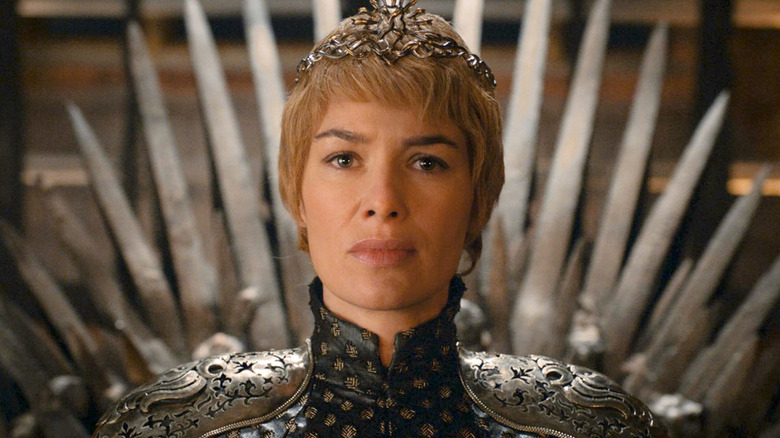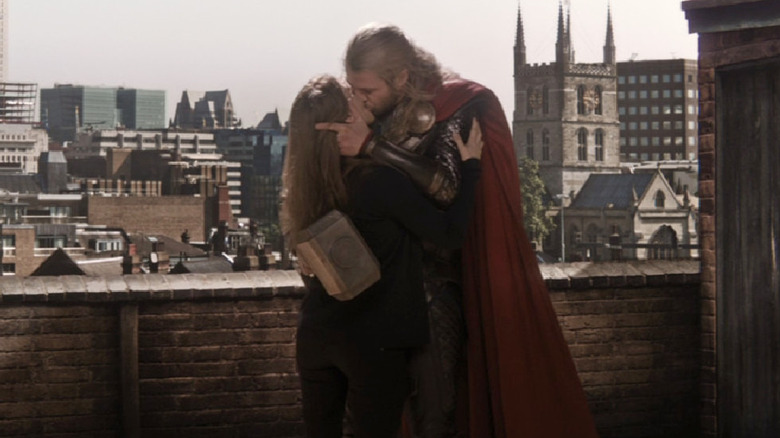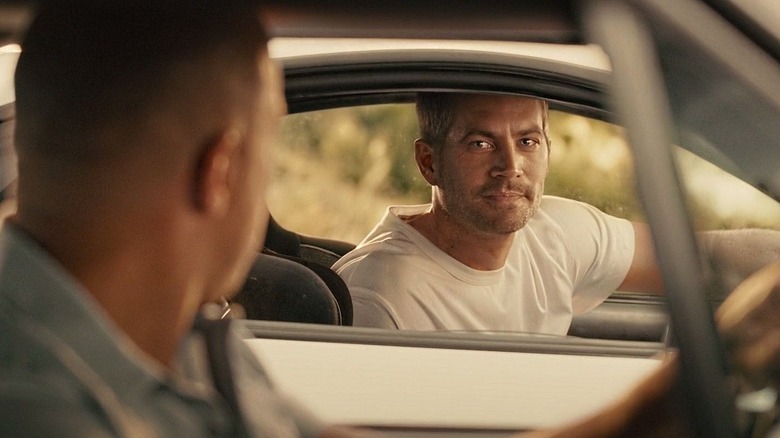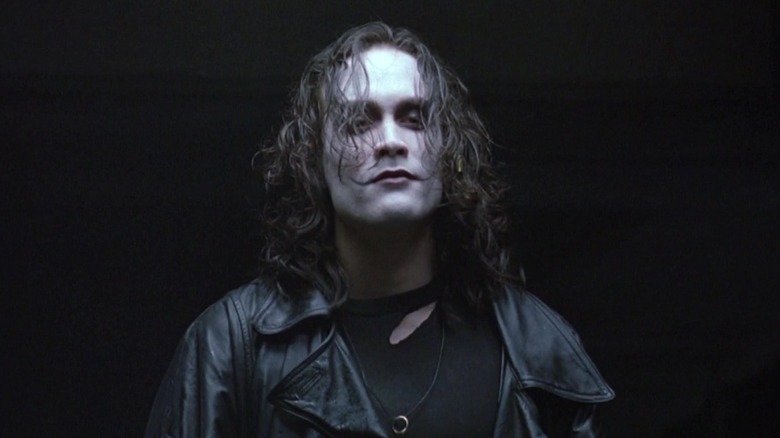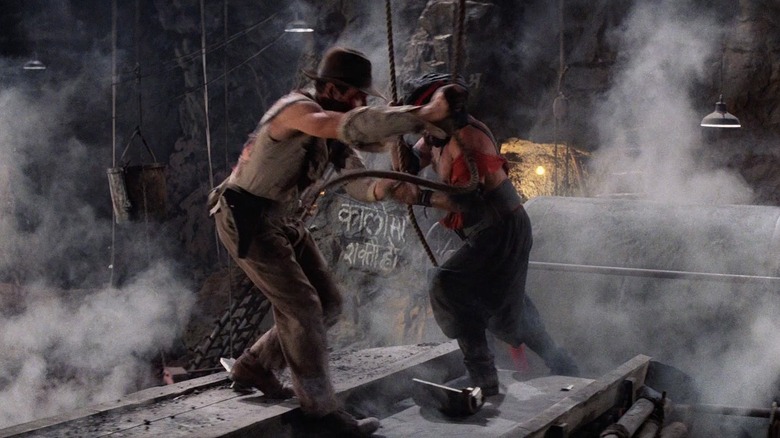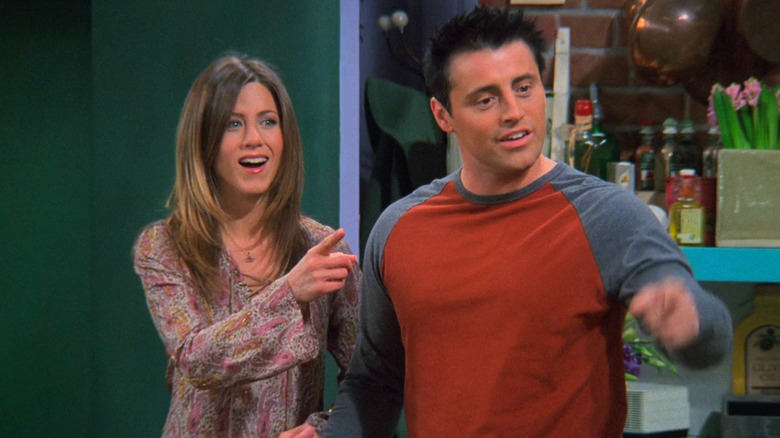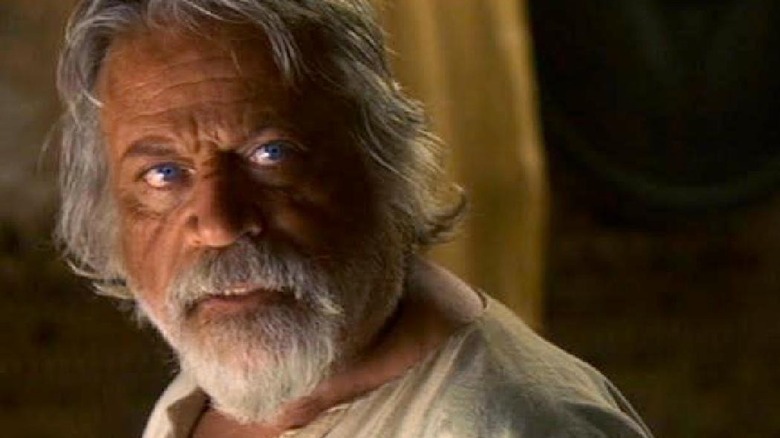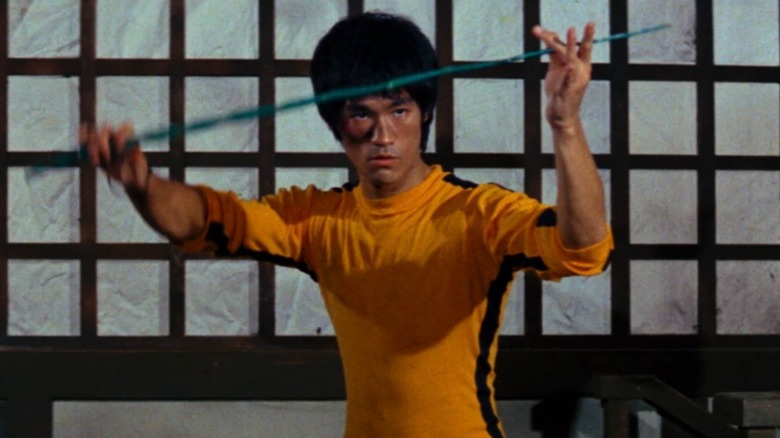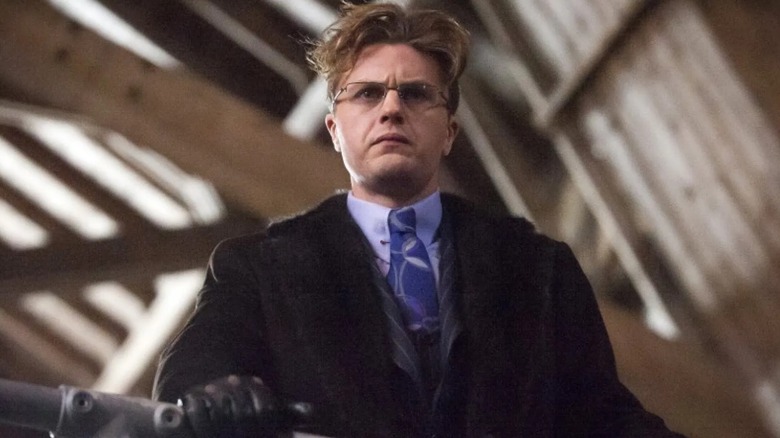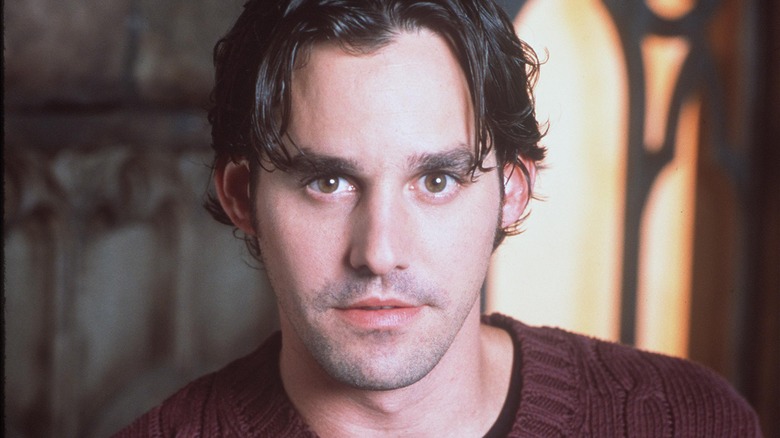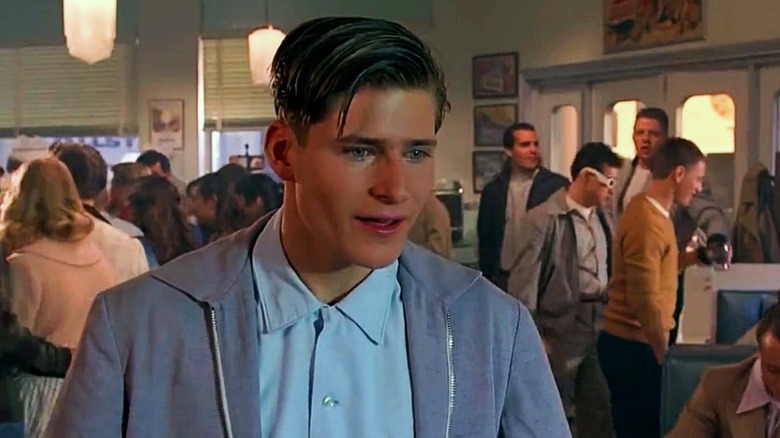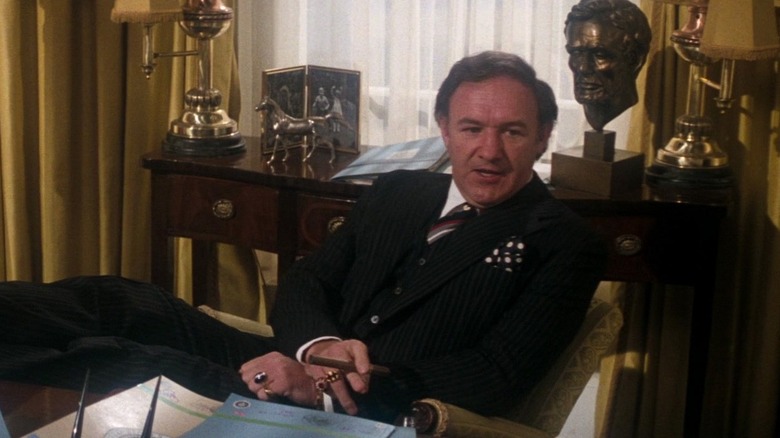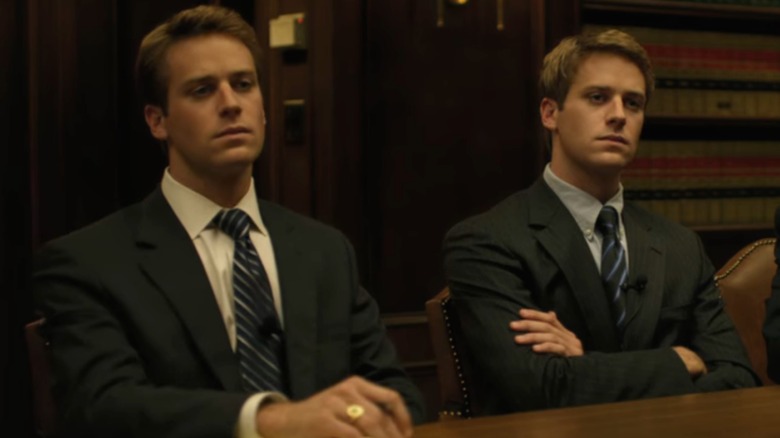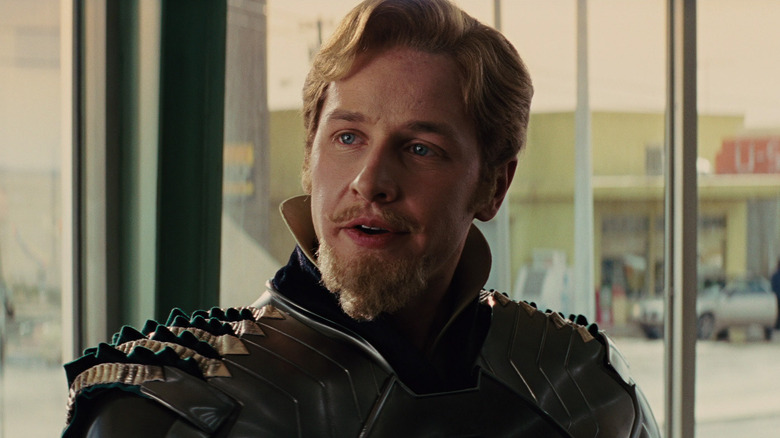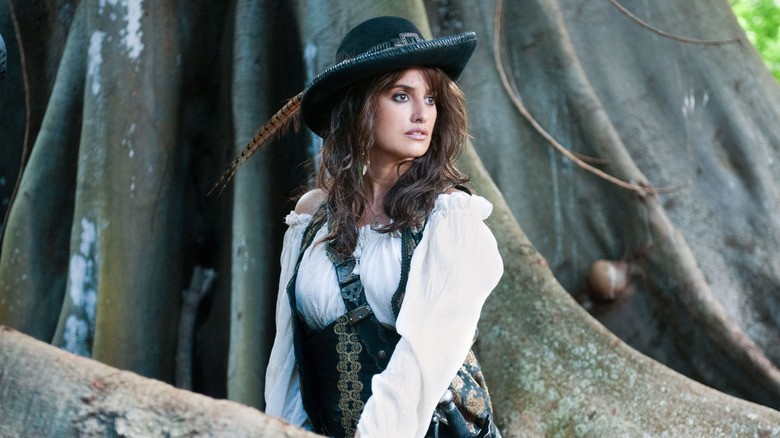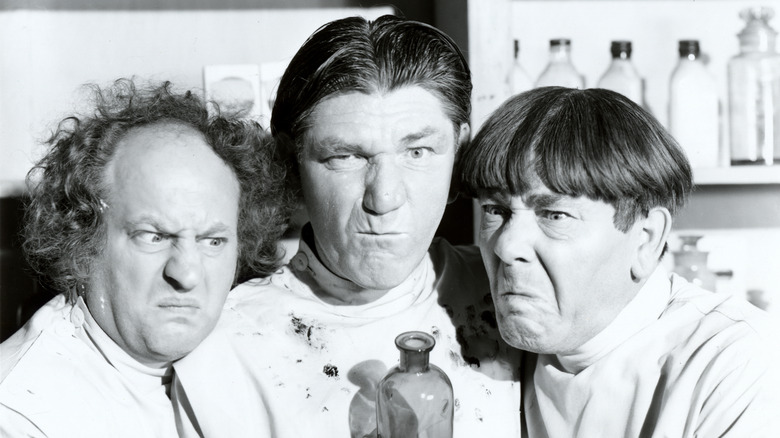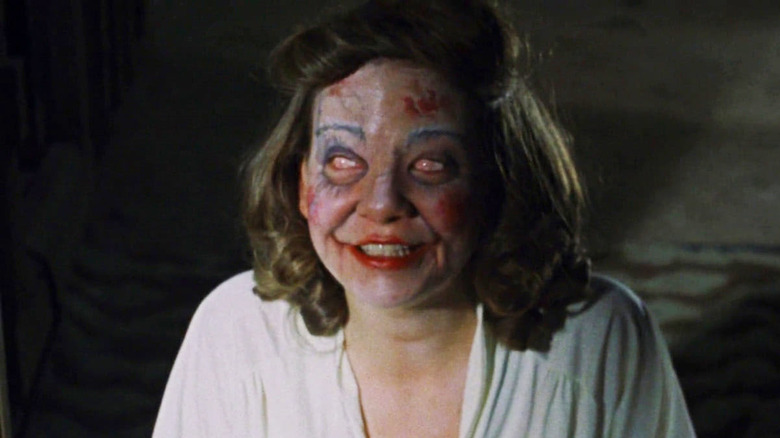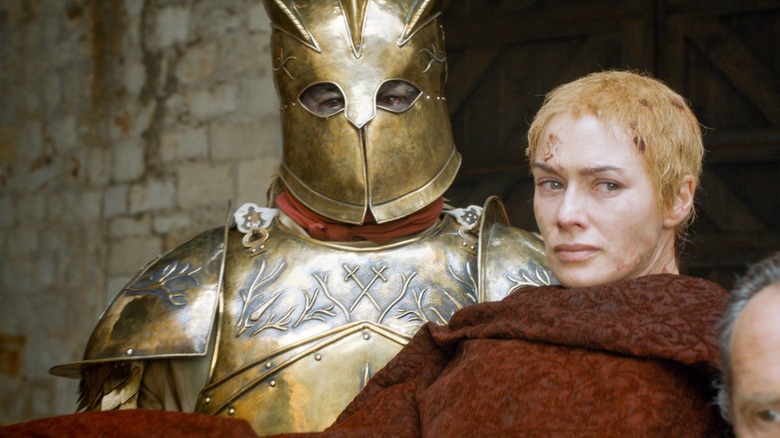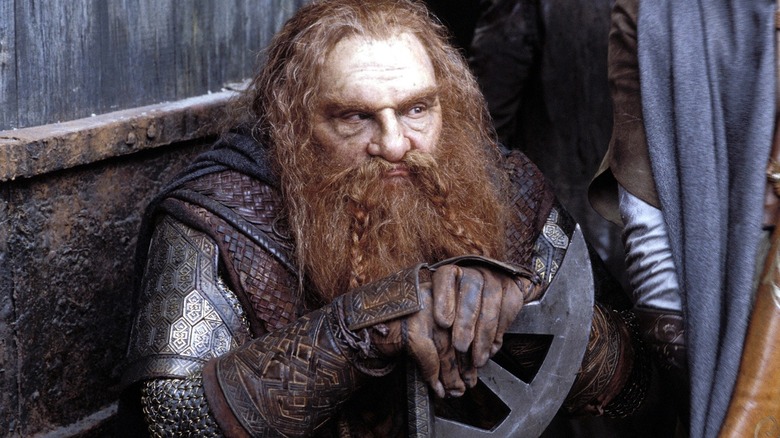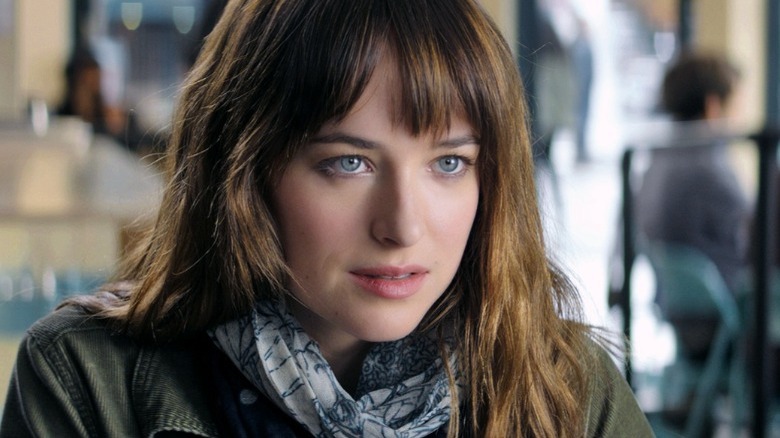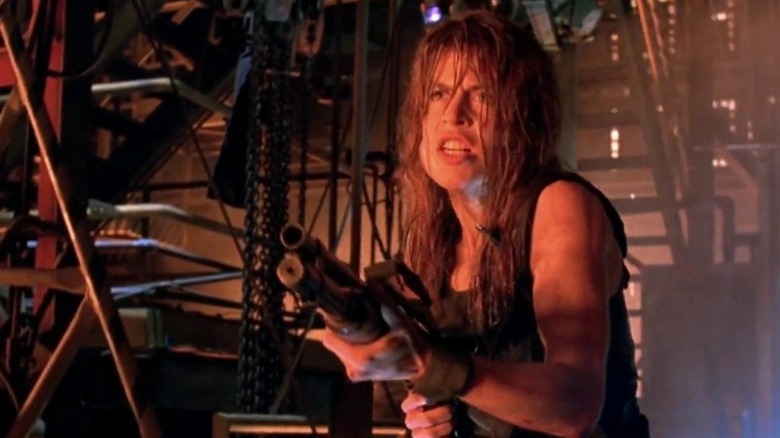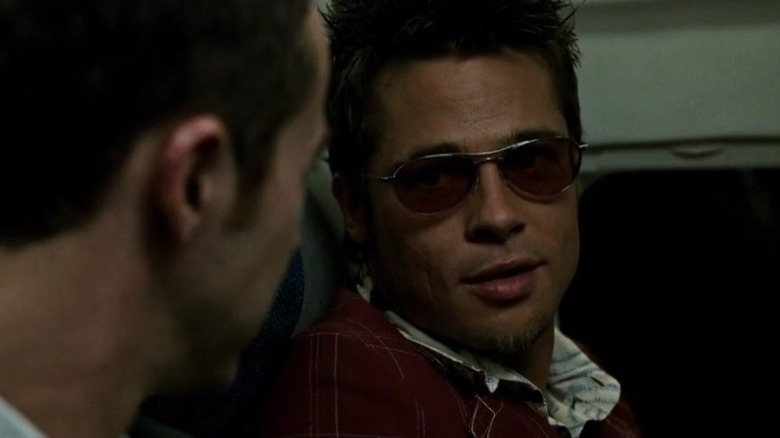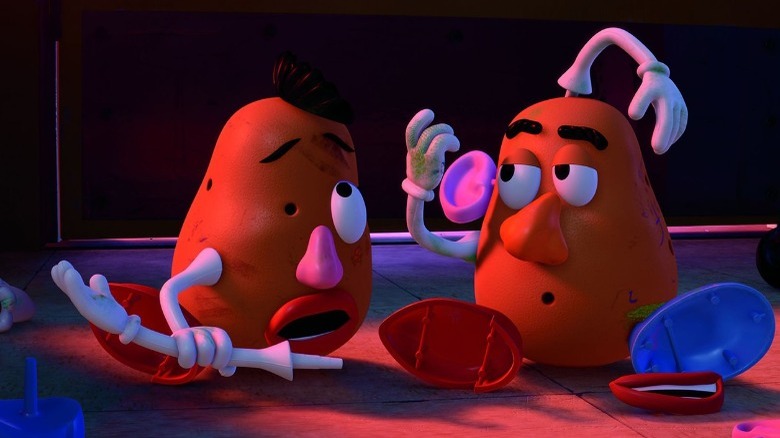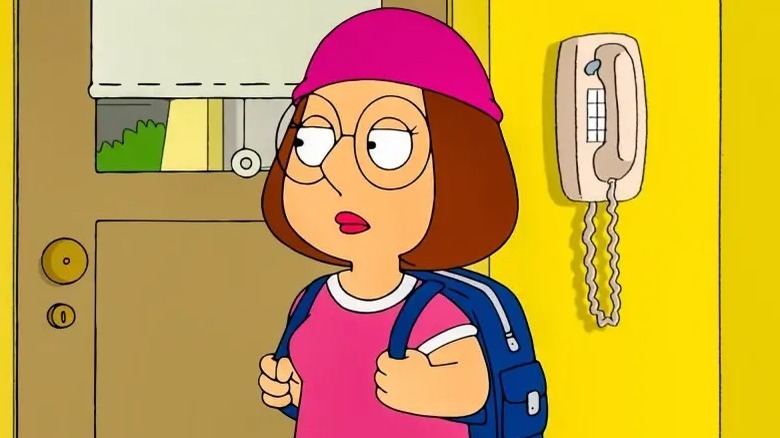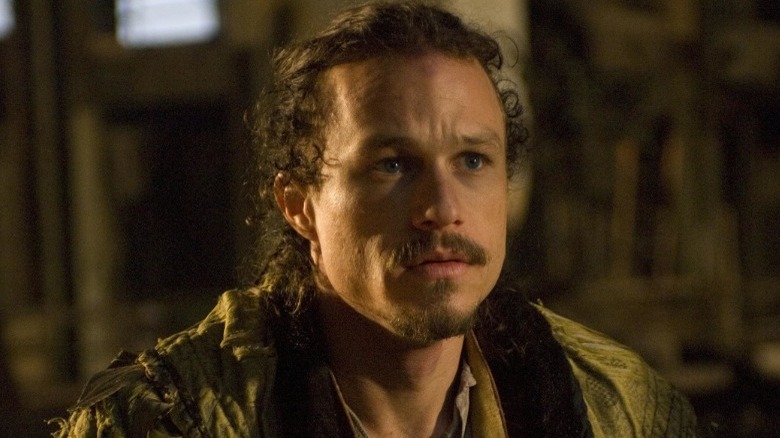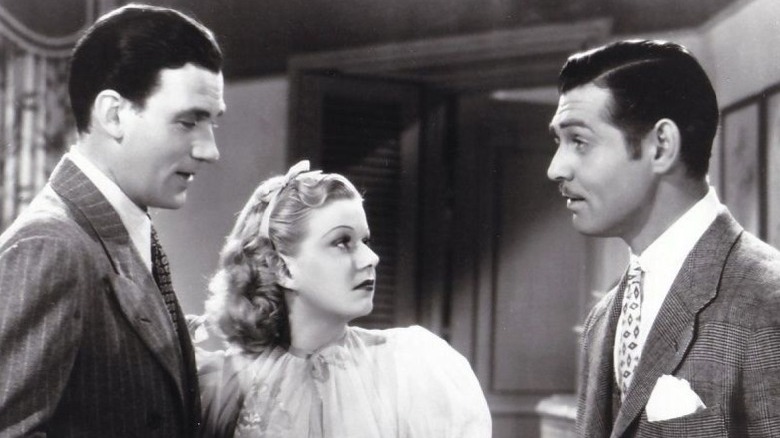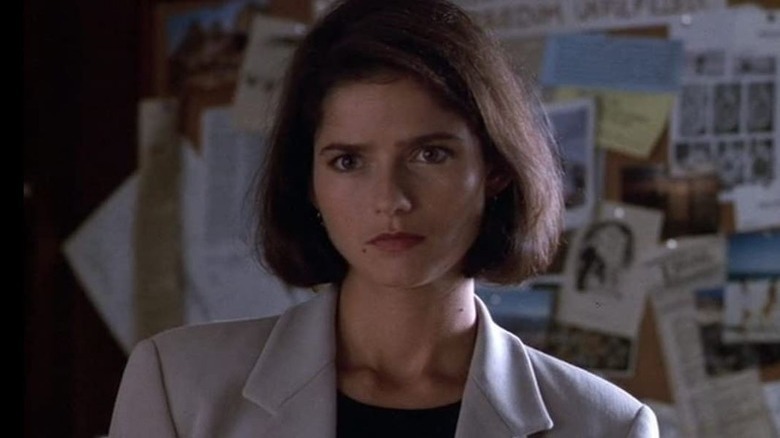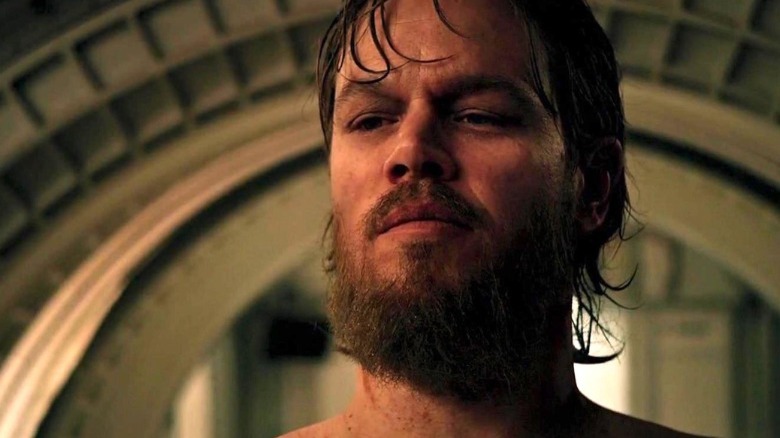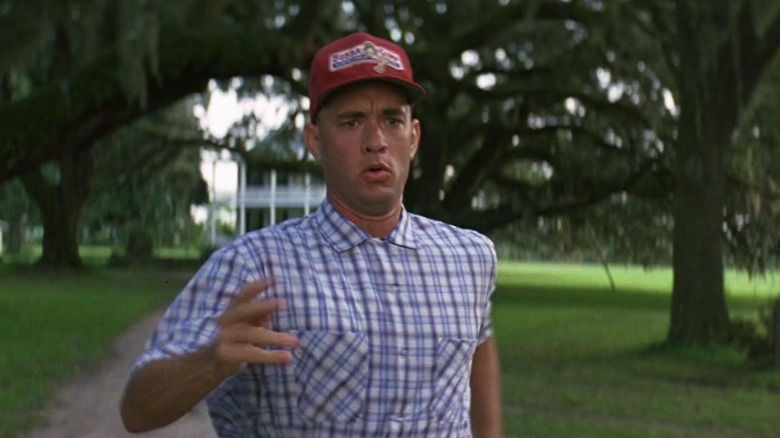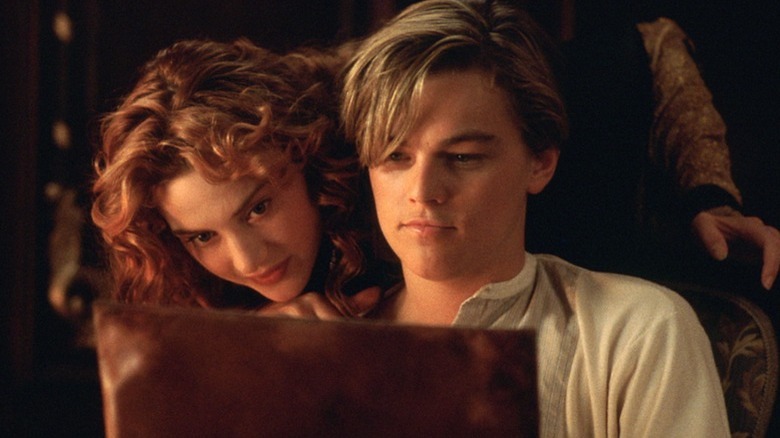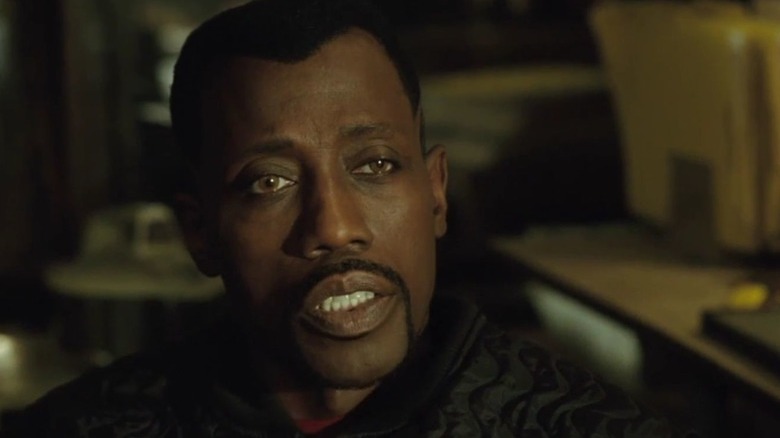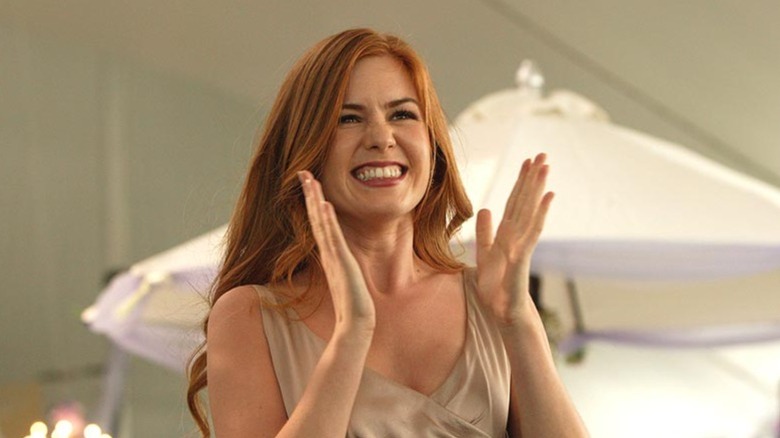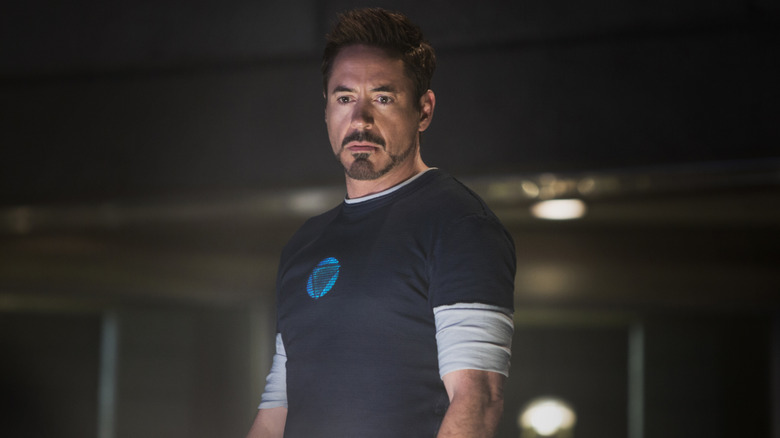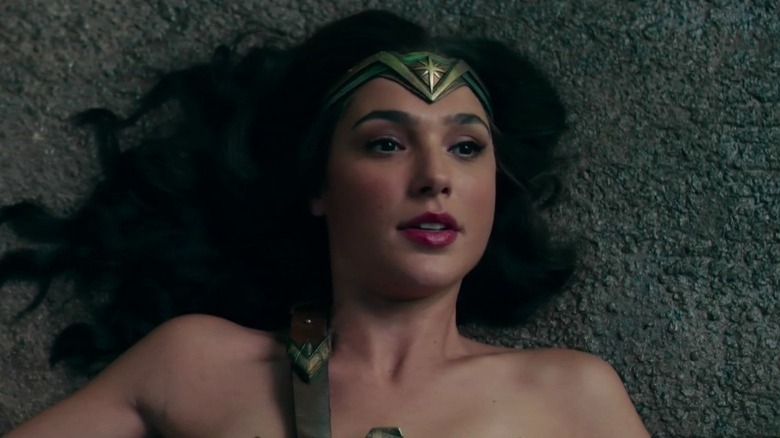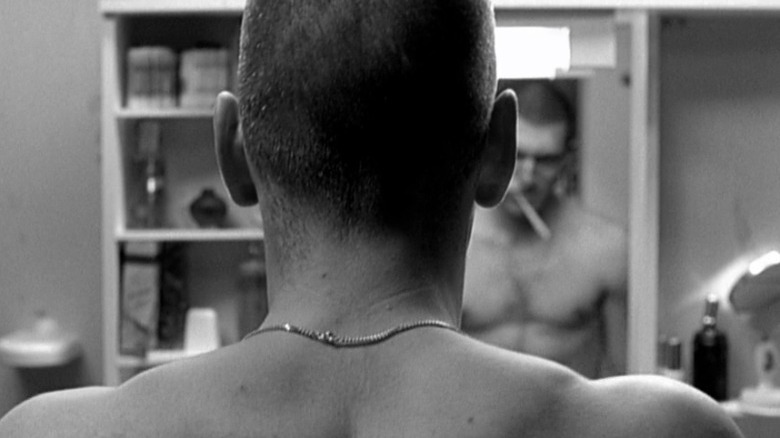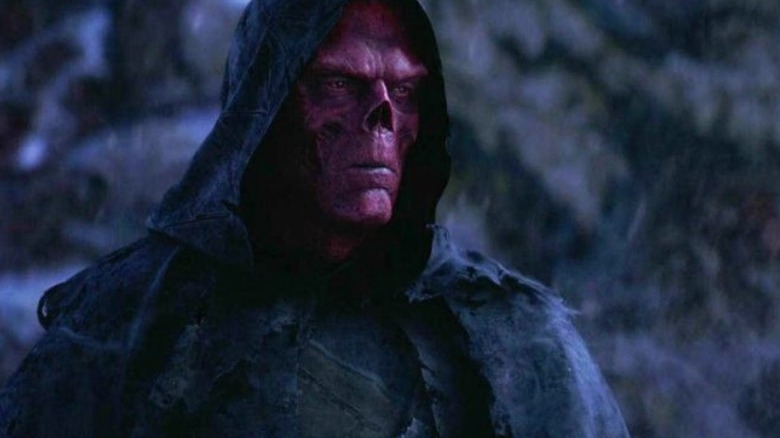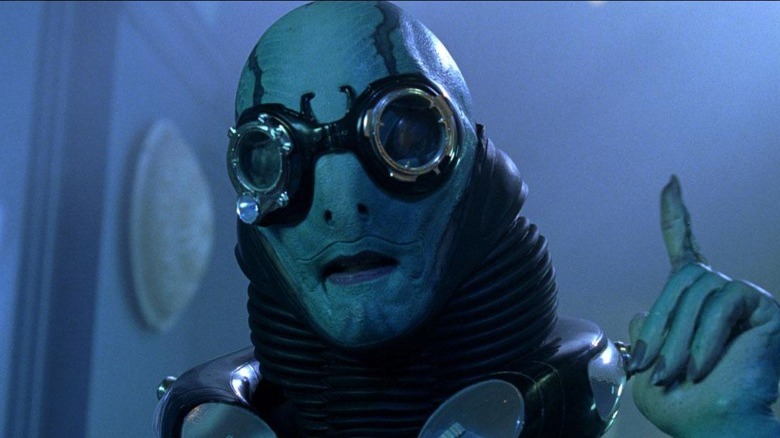Stars Who Were Replaced And No One Noticed
Most of us are used to the idea of an actor getting a role and, you know, acting the part. We'll accept a stunt double for scenes where the actor needs to jump out of a plane, fight a venomous snake, or kiss Ricky Gervais. But for the most part, if we're watching Gary Busey, we want to see Gary Busey. (Wait, why do we want to see Gary Busey again?)
Anyway, as it turns out, despite how much we think we're paying attention to the movie or TV show that's playing right in front of our bleary eyes, we're not actually always watching who we think we're watching. Even crazier, this kind of thing happens much more often than we realize. There have been plenty of times when actors were swapped out, and those of us in the audience never even noticed. Hold onto your hats everyone ... this is about to blow your mind. Or, at the very least, mildly surprise you while you read this when you should be working.
Natalie Portman - Thor: The Dark World
The heated kiss between Thor and Jane Foster in the post-credits scene of "Thor: The Dark World" is one of the steamiest moments in all the Marvel movies, and with good reason: actor Chris Hemsworth isn't making out with his costar Natalie Portman, but his real-life wife, Spanish actress and "Fast and Furious" star Elsa Pataky.
The scene, in which Thor forsakes his homeland, Asgard, to be with Jane full-time, wasn't finished during regular filming; the kiss was shot later, well after principal photography had wrapped. "[Hemsworth] was working in Hong Kong and I couldn't get there because I was working on my own film," Portman told the New York Daily News, "and so they put his wife in my wig and costume, that's why it was so passionate."
While many women would be upset to miss out on an opportunity to lock lips with Hemsworth, Portman doesn't seem to be one of them — as she put it, "It was such a perfect solution, wasn't it?" Besides, for the 5'3" Portman, kissing the "Thor" actor — who measures in at 6 feet, 4 inches — might be more trouble than it's worth. While filming other kissing scenes in the "Thor" series, Portman said on "The Graham Norton Show" (via Us), "They usually had a ramp for me to walk up so I could land somewhere near his face."
Paul Walker - Furious 7
"Furious 7" was maybe halfway through filming when series star Paul Walker tragically died in an automobile accident. The production shut down temporarily so that producers could consult with Walker's family on what they'd like to do. As the star of the film, there was no way to move forward without him, and there simply wasn't enough footage filmed already to try to cobble a movie together.
Walker's family agreed that the movie should be finished and his two brothers volunteered as stand-ins, since both closely resembled the actor physically. With the help of the special effects crew at Weta, who brought Gollum in "The Lord of the Rings" and Caesar in "Rise of the Planet of the Apes" to life, visual effects turned Cody and Caleb Walker into Paul Walker for the remainder of the film. "Furious 7" went on to be the biggest hit of the franchise and one of the biggest films of all time, grossing over $1.5 billion.
Brandon Lee - The Crow
The son of legendary martial artist Bruce Lee, Brandon Lee was set to take Hollywood by storm, mixing his family name and legacy with his own charm and talent. Sadly, on the set while filming his breakout role in "The Crow," Lee was shot by a prop gun that had a dummy round left in the chamber. He died after six hours in surgery.
With only eight days left of filming to complete the movie, Lee's mother and fiancé both encouraged director Alex Proyas to finish the film. To complete it, Lee's friend and stunt double Chad Stahelski stood in for him while special effects were used to give him Lee's face onscreen. Another stunt double help finished out some of the other action scenes. The result is a movie in which Lee's role is perfect, and there's no indication of the tragedy that befell him.
Harrison Ford - Indiana Jones and the Temple of Doom
You might think that it would be impossible to mistake someone else for the iconic Harrison Ford. After all, he's one of the most recognizable actors on the planet, and he's appeared in legendary roles in some of the most popular movies of all time. Yet Steven Spielberg and his production team still pulled a fast one back in the 1980s that you probably never even noticed.
On the set of "Indiana Jones and the Temple of Doom," Harrison Ford suffered a pretty severe back injury that sidelined him for several weeks of filming. Director Steven Spielberg, however, was prepared for any eventuality and simply swapped Ford for his longtime stunt double Vic Armstrong, who actually looked and moved so much like Ford that he managed to confuse Spielberg on the set more than once. A number of action scenes were filmed without Ford, including the epic fight between Indy and the massive Thugee cult member on the conveyor belt in the mine.
Jennifer Aniston - Friends
"Friends" was a massive success and Jennifer Aniston is arguably the biggest star it produced. Which makes it all the more unusual that it took years after the show was off the air for someone to finally notice one episode in particular in which Aniston inexplicably disappears.
In Season 9, Episode 15 ("The One With the Mugging"), a fan watching a "Friends" marathon happened to notice that in one scene when Aniston is standing next to Matt Leblanc, it's not Aniston at all. Seems that Aniston's stand-in was on set that day and, for whatever reason, her scene wasn't cut or edited in such a way as to remove her from the shot. The presence of a stand-in isn't such a crazy thing; after all, stand-ins are on set to replace actors when they're not available. It's just that they usually don't end up in the final cut. The stand in has since been edited out of the episode.
Oliver Reed - Gladiator
British actor Oliver Reed was just as famous for his hard-partying ways as he was for appearances in films like "Oliver!", "Women in Love," and "Tommy," and when he died in 1999 after a night of heavy drinking, friends agreed (via The Guardian) that he "he probably went the way he would have wished." They're most likely right — in a 1994 interview, Reed gave his own obituary, which began, "I died in a bar of a heart attack full of laughter." However, while Reed's passing might have been ideal for the actor, it caused a major headache for the cast and crew of "Gladiator," which he was filming before his demise.
As "Gladiator" visual effects supervisor Rob Harvey told the BBC, Reed's death forced the "Gladiator" team to rewrite the film's ending, and it still required quite a bit of visual trickery to pull together. Some of Reed's performance was cobbled together from outtakes (one dedicated fan has identified places where director Ridley Scott and his editors used the same footage more than once). The rest of the time, especially during wide shots, a body double with Reed's face digitally attached filled the void. "It's a very weird thing to have to do," Harvey admitted, "particularly [in 1999], when the technology wasn't really there at all." Still, it worked well enough — Reed was nominated for a BAFTA for his "Gladiator" performance in 2001, nearly two years after he passed away.
Bruce Lee - Game of Death
When superstar Bruce Lee was offered the role of Lee in Robert Clouse's seminal 1973 action movie "Enter The Dragon," he was in the middle of filming "Game of Death," and if Lee hadn't taken a break to make "Enter the Dragon," the martial artist's mysterious final project might have actually been completed.
As it is, Lee died of a brain edema on July 20, 1973, just a month before "Enter the Dragon" hit screens. That left "Game of Death," of which Lee had already filmed about 40 minutes, in limbo. Five years later, Clouse decided to finish what Lee started. Reportedly, Lee was changing the script for "Game of Death" while filming "Enter the Dragon," and the story was in constant flux. This left Clouse free to create a brand-new plot that worked around Lee's absence by including the actor's previously filmed scenes, shots from older Bruce Lee projects, and even footage from Lee's real-life funeral.
Clouse also hired stand-ins to play Billy Lo, Lee's character in the new version of "Game of Death." In Clouse's version, Lo undergoes plastic surgery and later wears a disguise, making it easy for Clouse to replace Lee with actors like Kim Tai-chung and Yuen Biao, Bruce Lee's stunt double on "Enter the Dragon." While the low-budget archival footage is glaringly obvious, the stand-ins work reasonably well (aside from a few oddities, like a scene in which Kim Tai-chung looks in a mirror and sees a cardboard cut-out of Lee's face staring back at him).
Michael Pitt - Hannibal
It's hard to imagine anyone more villainous than Hannibal Lecter, but the cult favorite TV series "Hannibal" gave us just such a character. As the sadistic meat-packing tycoon Mason Verger, "Boardwalk Empire" star Michael Pitt spends the second half of the show's second season tormenting Mads Mikkelsen's Hannibal, Hugh Dancy's Will Graham, and Katharine Isabelle, who plays Verger's twin sister Margo. Pitt delivers an equal parts electric and terrifying performance as Verger, who showrunner Bryan Fuller (via The A.V. Club) called "The Joker to Hannibal's Batman," until Verger finally falls under Hannibal's spell and suffers a grisly fate near the end of the season.
But while Mason and Margo Verger return in "Hannibal" Season 3, Pitt decided to pass for unknown reasons. When Mason reappears, ready for revenge against everyone's favorite cannibal, Joe Anderson appears in the role — even though Pitt and Anderson look nothing alike. Fortunately, in Pitt's last appearance on the show, Hannibal drugs Mason and convinces the villain to cut off his own face and feed it to Will Graham's pack of stray dogs. Anderson spends the entirety of "Hannibal" Season 3 covered in some truly gnarly make-up, which, combined with Anderson's convincingly consistent vocal performance, results in a seamless transition between the two actors.
Nicholas Brendon - Buffy the Vampire Slayer
Nicholas Brendon appeared in all but one episode of "Buffy the Vampire Slayer," and yet, surprisingly, he wasn't the only person to play Xander Harris, Buffy's geeky pal and perennial punching bag. Brendon's twin brother, who uses the stage name Kelly Donovan, often took Brendon's place when the actor wasn't available or when the supernatural shenanigans on "Buffy" required more than one Xander on screen at once.
Donovan made his most memorable appearance on "Buffy" in the fifth season episode "The Replacement," in which a demon creates a second Xander who threatens to take over the original's life. According to a post on Nicholas Brendon's now-defunct website, Donovan was supposed to be more of a stand-in, although he turned in such a convincing performance that Brendon, Donovan, and Brendon's wife Tressa di Figlia couldn't tell them apart. In the episode "Intervention," Donovan replaced Brendon entirely during some action scenes, as Brendon had pneumonia and couldn't come to the set.
Crispin Glover - Back to the Future Part 2
This may be the ultimate actor switcheroo. So egregious was this swap that it resulted in not just a lawsuit against the producers, but new regulations from the Screen Actors Guild to prevent it from ever happening again. So what happened?
Crispin Glover refused to reprise his role as George McFly in the sequels to "Back to the Future," due to a dispute over his salary or ethical concerns about the moral of the movie, depending on which story you believe. Unable to come to an agreement with Glover, producers recast the role with Jeffrey Weissman. So far so good, right?
Then they covered Weissman in make-up and prosthetics that had been cast from Glover's face in the first movie when they aged him for the scenes when he's older. Weissman became a Crispin Glover doppelganger, basically trading on the actor's appearance without actually using him. After Glover's lawsuit, which he won, the Screen Actor's Guild made it a rule that no actor's likeness could be stolen in such a way again.
Gene Hackman - Superman II
It might be hard to imagine now, but in the '70s, only one big-budget superhero franchise ruled the silver screen. With director Richard Donner at the helm and Christopher Reeve wearing the cape, the original "Superman" made $300 million at the worldwide box office — almost six times its budget — and established the template for almost every superhero film to follow.
After success like that, you'd expect Donner to return for the sequel. Sadly, that wasn't the case. During filming, Donner argued with producers Ilya and Alexander Salkind about the film's budget, and although Donner had already filmed roughly 75% of "Superman II" during production of the first film, he was replaced by "A Hard Day's Night" director Richard Lester. In order to secure a director's credit, Lester reshot quite a bit of Donner's footage, substantially changing the story and tone of "Superman II" in the process.
The way the Salkinds treated Donner didn't sit well with the cast. Reportedly, Reeve was openly furious about Donner's dismissal. Gene Hackman, who played Lex Luthor in both films, flat-out refused to show up to finish shooting "Superman II." With Hackman absent, Lester and the Salkinds were forced to use body doubles and voice impersonators for Hackman in order to bring "Superman II" to completion.
Josh Pence - The Social Network
In 2010, Armie Hammer made headlines (and picked up a couple of awards) for his portrayal of Olympic athletes, would-be entrepreneurs, and identical twins Cameron and Tyler Winklevoss, but he couldn't have done it alone. On the set, Tyler was actually played by "Draft Day" and "Gangster Squad" star Josh Pence. Later, Pence's face was digitally replaced by Hammer's by the "Social Network" visual effects team.
In order to prepare for the dual roles, Hammer and Pence attended a "twin boot camp," where together they worked out each twin's particular quirks and mannerisms, and while Pence's career didn't taken off like Hammer's (nor crumble like Hammer's either), he's become more positive about his "Social Network" experience over time. For his part, Hammer remained effusive about Pence's performance, as did the real-life Winklevoss twins, who met their onscreen counterparts for a round of drinks around the time of the film's premiere.
Josh Dallas - Thor: The Dark World
For such a small role, Marvel Studios sure had a lot of trouble casting Fandral the Dashing, the swashbuckling lothario of the Warriors Three. First, "Chuck" star Zachary Levi was set to play the goateed Asgardian, but had to drop out when NBC ordered more third season episodes of "Chuck." Next, Marvel cast "Queen of the Damned" and "League of Extraordinary Gentlemen" star Stuart Townsend in the role, but Townsend departed shortly before filming due to mysterious "creative differences." Marvel finally found its Fandral in a then-unknown actor named Josh Dallas, who finally brought the classic character to the screen.
But the trouble didn't stop there. Between the premiere of "Thor" and the start of filming on "Thor: The Dark World," Dallas landed the plum role of Prince Charming on ABC's fairytale drama "Once Upon a Time." Because of the show's rigorous shooting schedule, Dallas couldn't join his fellow Warriors for their big screen return, and Marvel needed to recast the part. Their choice? Zachary Levi, of course, who was finally free to take the role after the five-season run of "Chuck" came to an end. Thanks to Fandral's signature facial hair (and, honestly, his limited screen time), Levi effortlessly picked up right where Dallas left off, leaving audiences none the wiser.
Penelope Cruz - Pirates of the Caribbean: On Stranger Tides
Mónica Cruz has been an accomplished dancer and actress for years, and while she has featured roles in movies like "Asterix at the Olympic Games," "Last Hour," and "Jerry Cotton," she's probably most famous in America for her part in "Pirates of the Caribbean: On Stranger Tides" — in which she played her sister, Penélope.
Penélope took over from Keira Knightley as the female lead in Rob Marshall's 2010 sequel, in which she played Angelica, Jack Sparrow's love interest. However, while filming, Penélope learned that she was pregnant. In order to minimize the risk to Penélope's unborn baby, Marshall hired Mónica (who, despite being three years younger, looks quite a bit like her older sister) to serve as a stand-in. In an interview with The Telegraph, Penélope said she spent over two months training for the movie's tricky sword-fighting scenes, but admitted that, ultimately, they were just too dangerous for her to film alone. Thankfully, Penélope said, Mónica is "a dancer and very good with a sword because she's done a film herself," and audiences didn't notice the switch.
Shemp - The Three Stooges
Shemp Howard of the Three Stooges was contracted along with the other Stooges to produce eight films in 1956. Unfortunately, four films into the contract, Shemp Howard died of a heart attack at age 60. And in the 1950s, no one gave a damn if you died or not, your contract needed to be fulfilled. Thus was born the "Fake Shemp."
Producer Jules White set about producing four brand new films, each starring Shemp, by cutting together footage from older Stooges films with new scenes featuring Joe Palma, an actor who had long filled supporting roles in Stooges films. They just filmed him from behind or with his face obscured. The Stooges carried on for quite a while after Shemp's passing, recruiting first Joe Besser and then "Curly Joe" DeRita to fill out the lineup until the comedy trio quietly retired in the early 1970s.
The Cast of The Evil Dead
The term "Fake Shemp" was actually coined by "The Evil Dead" director Sam Raimi because he needed to use so many of his own fake cast members during production of his iconic horror film. As star Bruce Campbell recounted in his memoir If Chins Could Kill, Raimi and the actors couldn't always work on the same schedule because "The Evil Dead" was so ultra low-budget.
The result was that Raimi sometimes needed to film what he could when he could and with whom he could, which meant no fewer than 18 stand-ins were used during production. One of the busiest was Raimi's brother Ted, who subbed numerous times for other actors on the set. Even Sam himself used his own hands in one shot in place of actor Richard DeManincor's. That's pretty incredible, as the end result shows no sign that so many extra people were involved.
Lena Headey - Game of Thrones
Lena Headey's performance as Cersei Lannister, the ultimate villain on HBO's "Game of Thrones," made her into one of those iconic characters that fans love to hate. So viewers watched with a bit of sadistic glee when the character was literally and figuratively dressed down to be paraded through the streets of King's Landing in nothing but a short haircut and smears of filth, in a scene long anticipated by readers of the books and dreaded by Headey herself.
The scene is intense and humiliating and painfully drawn out so the audience can experience every minute of her awkward humiliation. The craziest part, however, is that we're not even watching Headey — at least not all of her — in the scene. The entire walk is performed by a body double, seamlessly merged with Headey's facial expressions and body language to make one awkward, horrible journey to the Red Keep.
John Rhys-Davies - The Lord of the Rings
Veteran actor John Rhys-Davies actually had two roles in "The Lord of the Rings" trilogy. In addition to portraying the dwarf Gimli, who becomes a member of the Fellowship, he also lent his voice to Treebeard the Ent. This put him in the unique position of being a physical actor on screen as well as a voice actor for a character created with special effects. Yet the actor didn't spend quite as much time onscreen as Gimli as it appears.
There were actually a couple of reasons behind this. Rhys-Davies is over six feet tall and his height posed problems, considering the actor was supposed to be playing a diminutive figure who is not much taller than the hobbits. This wasn't a deal-breaker, though, as the filmmakers already had to employ a series of camera tricks and visual effects to get everyone on screen looking the right size. Instead, the main reason Rhys-Davies was swapped out so much during filming was down to a severe allergic reaction he had to the prosthetic makeup used as part of his costume.
Unless the scene involved a close-up of Gimli's face or the character speaking, the chances are that it was actually stunt double Brett Beattie. In total, Beattie spent more than 2,000 hours as Gimli and became such an integral part of the cast that he was offered the opportunity to get a matching tattoo with the rest of the Fellowship actors.
Dakota Johnson - Fifty Shades of Grey
Although it was far from her first role, "Fifty Shades of Grey" did bring Dakota Johnson to the public's attention and helped make her a worldwide star. Based on the erotic fiction novels by E. L. James, the series sees Johnson as the young and relatively naïve Anastasia Steele, who embarks on a journey of sexual awakening with Christian Grey (Jamie Dornan). Just like the novels, the movies feature graphic encounters that include everything from bondage to sadomasochism.
So it might not come as a surprise that the young actor had a double who stood in for her, as many actors request for intimate scenes. But it wasn't a case of shyness or an unwillingness to appear naked that spurred the decision. Instead, Johnson had a large tattoo on her backside that would have been difficult to hide. Feeling that the tattoo wasn't in keeping with Anastasia's character, the filmmakers replaced Johnson in bare scenes with someone who looked close enough like her in terms of body shape and size that the switch wouldn't be noticeable.
Linda Hamilton - Terminator 2: Judgment Day
While Arnold Schwarzenegger is undoubtedly the face of the "Terminator" franchise, the main protagonist and only other figure who is present throughout most of the series is Sarah Connor. A number of women have taken on the role of the battle-hardened fighter over the years, but Linda Hamilton is most closely associated with the character, having appeared in a total of three films. The second of these outings came in "Terminator 2: Judgment Day," with Sarah battling against an upgraded T-1000 Terminator (Robert Patrick) with the help of her son (Edward Furlong) and a reprogrammed T-800 (Schwarzenegger).
Near the end of the movie there is a moment when the T-1000, which can morph into any shape or form, takes on the appearance of Sarah in one last attempt to lure out John Connor so it can kill him. At this point, it isn't immediately clear which is the real Sarah as they both appear on screen at the same time. Director James Cameron didn't use CGI to achieve the effect, with one of the Sarahs instead played by a different actor. The person in question was not a professional actor, but a nurse named Leslie Hamilton Gearren, who just so happened to be Linda Hamilton's twin sister. The pair look so alike that viewers would never know the original actor wasn't playing both parts.
Brad Pitt and Helena Bonham Carter - Fight Club
It isn't unusual for actors to tap out for intimate scenes and instead have a stand-in play the part of the character. They might have objections to appearing naked or simply be uncomfortable with that type of scene. In the case of "Fight Club," the sheer amount of time needed to film the scene may have caused the switch to body doubles so that the actors could work on other scenes simultaneously.
Speaking to Vulture, body double Laura Grady explained that she and Brad Pitt's body double filmed the scene with director David Fincher over the course of two weeks. "So we spent two weeks with David Fincher on a set and green-screen, just re-enacting all of those *** scenes," she said. "I did see Brad Pitt and Helena Bonham Carter throughout the day, but they were never in my scenes." The end result is so convincing that it is unlikely to raise any suspicions that it was not the two lead actors in the scene.
Don Rickles - Toy Story 4
Mr. Potato Head isn't exactly the main character of the "Toy Story" franchise, but he still plays an important role in the franchise. Throughout the entire series, up until "Toy Story 4," legendary actor and stand-up comedian Don Rickles was responsible for providing the voice of Mr. Potato Head. Unfortunately, before the script was completed for the 2019 movie, Rickles died at the age of 90. At this point, the actor had not recorded any lines, and this left the producers and directors in a quandary.
Rather than cut the character from the movie or replace Rickles, Pixar decided to try and recreate the voice using 25 years of archival material they had gathered from the three previous "Toy Story" movies and countless other projects involving Mr. Potato Head. With his family's blessing, they were able to find unused lines and dialogue that could be repurposed for the fourth film and ensure that Rickles continued to be a presence in the franchise. To fans who were unaware of this, it may well have seemed like the actor had recorded his lines before his death — which, in a sense, he did.
Lacey Chabert - Family Guy
Despite a rocky history of cancellations and controversy, "Family Guy" has become one of television's most popular and successful animated sitcoms. Since its debut in 1999, the show has broadcast over 400 episodes and largely retained the same voice cast for its core group of characters. Seth MacFarlane provides the voices of Peter, Stewie, and Brian, for example, while Seth Green and Alex Borstein have played Chris and Lois since the very beginning of the series.
The one outlier to this is Meg. Although few people realize it, Meg actually had a different voice actor throughout the first 14 episodes of "Family Guy." Lacey Chabert originally voiced the role until she was forced to leave due to other commitments, which included mounting school work and a role on the drama series "Party of Five."
Mila Kunis was subsequently hired to replace her, but viewers continued to see several alternating episodes where the voice actor swapped back and forth as the broadcast order differed from the recording order. So even those who did notice a difference might have thought it was a recording issue or a choice on the part of the show's creators, rather than a change in voice actor.
Heath Ledger - The Imaginarium of Doctor Parnassus
This example is a little different from the rest, as it is impossible not to notice that Heath Ledger's character in "The Imaginarium of Doctor Parnassus" was also played by several other actors, namely Johnny Depp, Colin Farrell, and Jude Law. What you may not have realized, however, is that this was never intended to be the case and that Ledger would have originally portrayed Tony Shepard throughout the entire film if it wasn't for his tragic death.
The actor died just a month into production, long before his scenes were completed. This left the movie in a state of limbo for several months. During that time, director Terry Gilliam developed the idea of Shepard magically transforming into different versions of the character as he travels through dream worlds. This allowed "The Imaginarium of Doctor Parnassus" to be completed and for the change in actor to be plausibly explained within the fictional narrative.
The fantasy elements of the film also meant that the switch would not be too distracting for audiences, as the dream-like sequences allowed for the distortion of reality. Many people who watched the film may have been completely unaware that Depp, Farrell, and Law were replacements for Ledger, and not part of the original story.
Jean Harlow - Saratoga
Jean Harlow is another example of an actor who died before she could complete the filming of her last project. In this case, it was the romantic comedy "Saratoga." The film sees Harlow appear opposite Clark Gable as the granddaughter of a farm owner who has recently become engaged to a wealthy businessman. Unfortunately, Harlow's health suffered even before production started, with reports suggesting that she had sun poisoning and numerous infections.
A heavy drinker in her later life, Harlow may not have been able to tell that some of her symptoms were indicative of a serious condition. The actor had constant headaches, suffered from bouts of vomiting, and had a swollen face. She was eventually diagnosed with renal failure, following damage to her kidneys from scarlet fever when she was a child, and died on June 7, 1937.
By this point, "Saratoga" was largely completed, although Harlow had not filmed all of her scenes. The studio initially wanted to recast the part and reshoot all of her scenes, but fan outcry forced a change. Instead, Mary Dees performed the physical part of Harlow on screen, with the director disguising her appearance by using shots and angles that obscured her face, while Paula Winslow imitated the actor's voice to provide the character's dialogue.
Jill Hennessy - Law and Order
Jill Hennessy is an experienced actor who has had roles in everything from "Crossing Jordan" to "Wild Hogs" to "Exit Wounds." Yet she is probably best known for portraying prosecutor Claire Kincaid in "Law and Order," a role she held for three seasons. Over the course of 69 episodes, Jill was an integral part of the show, but she was forced to let someone else play Kincaid for a single episode in Season 6.
Although she did film some parts for the episode, she was unavailable for other scenes as she was busy filming a special crossover episode of "Homicide: Life on the Street" that featured several characters from "Law and Order." Rather than delay filming, the director took advantage of the fact that Jill has an identical twin sister. Jacqueline Hennessy is a television host and magazine editor who shares a striking resemblance to Jill.
Jacqueline had no lines but appears in several scenes of the episode "Corpus Delicti," usually sitting at the prosecutor's table in the courtroom as other lawyers argue the case. This allowed filming to go ahead without the need to totally omit Kincaid — and fans would have never known that a switch had taken place if it hadn't been revealed.
Matt Damon - The Martian
Matt Damon has been involved in some pretty great movies during his career and he has never been afraid to do whatever it takes to get the necessary performance for the role. One of the recent highlights was "The Martian," a 2015 adaptation of Andy Weir's novel. Damon plays Dr. Mark Watney, an astronaut who is left behind and has to survive alone on Mars as NASA races to rescue him. Part of his struggle involves getting enough food to stay healthy, something that leads to the astronaut losing a lot of weight.
While it isn't uncommon for actors to lose or gain weight for certain roles, Damon didn't end up having to starve himself for his role in "The Martian." While that may have initially been the plan, a heavy shooting schedule and other commitments made it impossible for Damon to lose a significant amount of weight for the movie.
According to Damon, the way "The Martian" was shot meant it was much easier and cheaper to use body doubles. The double was only used for two shots and his face is hidden or obscured in them, so it's almost impossible to know that it isn't actually Damon walking around as Dr. Mark Watney when watching the film.
Tom Hanks - Forrest Gump
Tom Hanks is undeniably one of the biggest movie stars on the planet. He has remained in demand over the course of more than four decades, with a wide array of hits ranging from "The Green Mile" and "Apollo 13" to "Catch Me if You Can" and "Toy Story." Of course, he's also demonstrated his award-winning acting skills in films like "Cast Away," "Philadelphia," and "Forrest Gump."
As anyone who has seen Robert Zemeckis' 1994 film will know, Forrest does a lot of running during the movie — an impressive feat given that as a child the character wears leg braces and struggles to walk. Obviously, Tom wasn't expected to do all that running himself, and a stand-in was often needed so the actor could film more important scenes elsewhere. The problem was that Tom has a very particular gait when running and the filmmakers struggled to find anyone who could replicate it.
That is until they came across Tom's brother, Jim Hanks. Thanks to the fact that they share the same DNA, Jim was able to run just like Tom and made the perfect body double, meaning that anytime Forrest is running on screen, there's a good chance it is actually not the Hanks you thought it was. Jim has since gone on to often double for his brother, notably voicing Woody from "Toy Story" in a number of spin-offs, video games, and toys.
Leonardo DiCaprio - Titanic
By the time "Titanic" came out, Leonardo DiCaprio was very much a heartthrob for millions of people around the world and a genuine film star, largely due to his breakout role in "Romeo + Juliet." The success of James Cameron's disaster epic, which became the highest-grossing movie of all time when it was released, made him an even bigger name. Appearing opposite Kate Winslet, the pair portray two lovers who begin a whirlwind romance while on the doomed ship.
At one memorable moment during the film, DiCaprio's Jack Dawson sketches a picture of a naked Rose (Winslet) while she relaxes in her stateroom. The scene depicts DiCaprio carefully drawing Winslet — although any close-ups of his hand putting pencil to paper are not his. Winslet revealed that it was actually James Cameron's hands during those shots and that the sketch was actually created by the director, who is a skilled artist. The footage was simply flipped in post-production so that it appeared as if Cameron's left hand was actually DiCaprio's right hand.
Wesley Snipes - Blade: Trinity
Wesley Snipes found a lot of success as the vampire hunter Blade during the late 1990s and early 2000s. As one of the first adult-focused superhero films, it set the stage for the darker and more mature adaptations that were to follow. After the first film proved to be a hit, two sequels were produced and David S. Goyer — who was responsible for penning the script of all three movies — eventually ended up taking on directing duties for the third and final outing.
That may well have proved a mistake for Goyer. "Blade: Trinity" ended up being a huge mess, as production troubles constantly affected the project. Snipes, now with an executive producer role, seemingly objected both to the script and the choice of Goyer as director. His co-star Patton Oswalt later spoke out about Snipes' behavior on set, claiming that his dispute with Goyer became so bitter that he refused to shoot scenes, spending all of his time in his trailer and only communicating by passing notes.
Goyer told Uproxx that making "Blade: Trinity" was "the most personally and professionally difficult and painful thing I've ever been through," with the director ultimately forced to get creative in order to finish filming. For anything but close-ups, Snipes' body double was used, meaning that whole chunks of the film don't actually feature the actor as Blade at all.
Isla Fisher - Wedding Crashers
Before coming to the U.S. and making it big in Hollywood, Isla Fisher was perhaps best known as a regular on the Australian soap opera "Home and Away." One of her first major film roles, and the one that helped propel her to stardom, was in the 2005 comedy "Wedding Crashers." Owen Wilson and Vince Vaughn star as two middle-aged men who spend their free time crashing weddings in their local area to try and seduce women, with Fisher's character Gloria becomes obsessed with one of them after they sleep together.
Many of the funny moments in "Wedding Crashers" come from the sexual activities of Gloria and Vaughn's character Jeremy as they get into some very risqué moments. However, for the vast majority of the time, none of these moments involved Fisher. Speaking to Entertainment Weekly, the actor explained how body doubles were used for nearly every encounter.
In fact, she fought hard to have nudity removed from the film altogether but was unable to convince the producers, so she instead opted to not appear herself. "I had a hand double for the under-the-table scene," she said. "I had a breast double for the boob-in-the-face and I had a butt double. That may have been the same person."
Robert Downey Jr. - Iron Man 3
Robert Downey Jr. was the face of the Marvel Cinematic Universe for more than a decade, with the actor donning the metal armor of Iron Man and helping to save the Earth from a vast array of threats. Of course, the MCU films are full of visual effects, so the fact that Iron Man is generally encased in an outer shell that covers his entire body meant that the character was probably quite frequently created only using CGI. After all, having Downey Jr. flying around fighting aliens would be pretty hard to insure.
When you can be sure that the actor is actually on screen is when we see Tony Stark out of uniform. Without the armor, Stark is just a talented human who would be impossible to capture on film without Downey to play the part. At least, that's what you might think. The truth is that the filmmakers created a fake version of the actor during production for "Iron Man 3" after he injured his ankle and was unable to walk for several weeks.
Rather than put a complete halt to filming, Weta Digital was able to use a body double to replicate Downey's performance and then merge the actor's face with the body double to make a convincing fake Tony Stark. Using this effect, the entire beach scene at the end of "Iron Man 3" was able to be shot without Downey even being present on set.
Gal Gadot - Justice League
2017's "Justice League" was Warner Bros.' first real chance to rival the MCU and show that it was capable of putting together an ensemble movie with the same impact as "The Avengers." Unfortunately for DC fans, the end result failed to match expectations and "Justice League" was something of a confusing mess. There are a lot of behind-the-scenes reasons for that, but chief among them was the fact that Joss Whedon was brought in to replace Zack Snyder as director.
Reshooting much of the film, Whedon inserted a number of completely new scenes. One of these involved the Flash (Ezra Miller) falling on Gal Gadot's Wonder Woman. It seems Whedon wanted this to be a funny comedy moment to inject some lightheartedness into the movie, but Gadot felt differently and the scene does have something of a creepy edge to it.
While there's never been confirmation from Gadot or Whedon, online rumors claimed that the actor refused to shoot the scene, forcing the director to use a body double. This is the reason why Gadot's face is rarely shown during this moment, as a stunt double is performing the part instead of her.
Vincent Cassel - La Haine
"La Haine" might not be as familiar to readers as some of the other films discussed, but that doesn't make it any less impactful or impressive. The 1995 French social thriller follows a group of three young men in the aftermath of riots near the suburbs of Paris. The trio try to come to terms with the violence they have seen and experienced, in addition to the brutal police attack on their young friend that has left him battling for his life in hospital.
Early in the film, one of the characters performs a monologue similar to the one that Robert De Niro delivered as Travis Bickle in "Taxi Driver." The young man stares at his mirror as the camera captures both him and his reflection moving and talking. Rather than use special effects to achieve the result, the filmmakers instead created two identical sets opposite each other, with all of the contents of the set flipped around so it looked like a reflection. Actor Vincent Cassel then stood in what was the "reflection room" as a body double mirrored his movements perfectly in front of the camera, with only his back and side visible. The effect is so convincing that you'd never guess it wasn't Cassel and a genuine reflection.
Hugo Weaving - Avengers: Infinity War
Hugo Weaving has always had a knack for playing villainous roles, and got his chance to play another antagonist in 2011 when he was cast as Red Skull in " Captain America: The First Avenger." A secretive HYDRA agent who works for the Nazis, Red Skull acquires his monstrous appearance after he consumes Abraham Erskine's Super Soldier Serum.
Following his appearance in that film, Red Skull was largely absent from the MCU until his sudden reemergence on the planet Vormir in "Avengers: Infinity War." This time around, though, the character was no longer played by Weaving. Instead, Ross Marquand took on the role, although fans may not have even realized this, given the extensive prosthetics and makeup used for the character.
Weaving has provided a few reasons why he didn't return for "Avengers: Infinity War" and "Avengers: Endgame." He told Collider that the first film was "good to do it and try it out, but to be honest, it's not the sort of film I seek out and really am excited by." He later explained that he was offered less money to reprise the role despite promises that he would receive a higher fee if he were ever to return to the franchise.
David Hyde Pierce - Hellboy II: The Golden Army
In 2004's "Hellboy," Bureau for Paranormal Research and Defense scientist Abe Sapien was played by two individuals: Doug Jones took on the responsibility of physically portraying the character onscreen, while David Hyde Pierce provided the voice. This wasn't necessarily what director Guillermo del Toro had in mind when he set out to make the film, but was essentially forced to use Pierce by the studio that financed the movie as a way of getting some bigger names involved.
The studio's plan didn't exactly work. Pierce felt Jones had already performed the voice for the character perfectly and chose to imitate his performance as closely as possible. The veteran actor even refused to receive any credit for the role, and when it came time for the sequel to enter production he declined to return. This led to Jones taking on the part completely instead of just being the onscreen actor, although the similarity in both vocal performances makes it difficult to tell that any change actually took place.
Without Pierce graciously stepping back, Jones might not have been given the chance to fully realize Abe for "Hellboy II: The Golden Army" and several other "Hellboy" projects without studio politics getting in the way.
